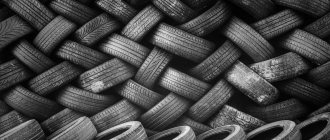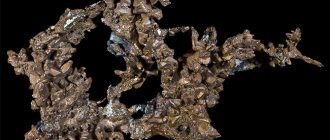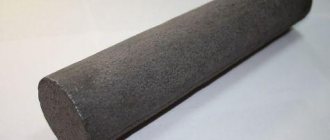24.04.2020
// Rubbers
Many years passed when travelers brought the ball from the island of Hispaniola. The object jumped after being thrown, surprising the aliens. The Indians called the material for making an elastic ball “rubber”, hence the name of rubbers - elastomers, natural and synthetic products. Scientists have been working on the creation of synthetic raw materials for 100 years. According to the formulas and methods of the Russian chemist S.V. Lebedev. in 1927 synthetic rubber was created, and in 1932 the first batches of rubber products were produced. Nowadays it is difficult to imagine industry and everyday life without products obtained by vulcanization of elements.
Natural rubber, characteristics and properties, composition:
Natural rubber has been known since ancient times. Scientists have found fossilized remains of rubber plants, their age is millions of years. Five hundred years ago, with the discovery of America, representatives of civilization learned about this material. At that time, the Indians quickly sold bottles and rubber shoes to people. However, rubber became truly in demand relatively recently, in the 30s of the 19th century: Charles Goodyear invented rubber in 1839 by inventing the vulcanization process. To do this, he heated rubber with sulfur, and the properties of the material only improved. This is how rubber was invented, and this is where its widespread use began. By 1919, over forty thousand types of products using this material already existed on the market.
Rubber consists of 91-96% isoprene polymer and has the following characteristics and properties: density 910-920 kg/m3, frost resistance or glass transition temperature 70 °C (i.e. it ceases to be plastic and acquires some qualities characteristic of glass), heat resistance up to 200 °C.
It does not dissolve in most liquids (water, alcohol, acetone, fatty acids) and does not swell in them. Swelling, it gradually dissolves in similar substances: gasoline, benzene, ether, toluene and other aromatic hydrocarbons.
Compression of natural rubber is accompanied by absorption, while stretching is accompanied by heat release.
When cooled, rubber becomes brittle; when heated, it softens. In both processes, rubber loses its elasticity. The interaction of natural rubber with ozone, oxygen and other oxidizing agents leads to increased brittleness and the appearance of cracks. Those. fragility increases, it “gets old”.
Like most polymers, depending on temperature, rubber can be in one of three states: highly elastic, viscous, and glassy. Under normal temperature conditions, rubber is highly elastic.
More than anything else, rubber is valued for its elasticity. Products made from it are able to quickly return to their original shape. This happens every time the deformation forces stop acting. The elasticity of rubber is one of the best in its class. For example, if a product made from it is stretched to 1000%, it will still return to its original shape. By the way, for ordinary solids this figure is 1%. Rubber retains these unique properties both when heated and when cooled.
In addition, the advantage of rubber is also manifested in the fact that it has high ductility. This means that under the influence of external forces this material will acquire and maintain its given shape. During mechanical processing or heating, this property is especially noticeable. Thus, rubber is considered a plasto-elastic substance.
However, natural rubber has a drawback: over time it hardens and, as a result, loses its properties.
Nature and science
The Mayan Indians made a kind of ball in this way. However, rubber in its pure form has several physical properties that have delayed its mass use around the world for a long time.
At high temperatures, rubber becomes sticky and can spread, emitting a rather unpleasant odor. At low temperatures it freezes and cracks.
But science moved forward, the scientist chemist Charles Nelson Goodyear conducted an experiment to improve the physical properties of rubber. Interaction with the chemical element sulfur led the resulting polymer to increased strength, elasticity, sound insulation properties, water resistance, non-conductivity of electricity and heat. This experiment opened the door for latex into global industries.
Where is it kept? Obtaining natural rubber:
For natural rubbers, the raw material source is the milky sap of some plants that produce latex (a white liquid with special properties). Latex itself is a fairly common component of plants and is found in representatives of rubber plants of various botanical groups.
It is found in different parts of plants. Therefore, they (i.e. plants) are classified as follows:
1. latex, when the substance accumulates in the milky juice,
2. chlorenchyma - the substance accumulates in young green shoots and leaves,
3. parenchymal - the substance accumulates in the roots and stems,
4. herbaceous latex plants of the Asteraceae family - these are Kok-sagyz, Crimea-sagyz and others, where rubber accumulates in small quantities in underground organs. These plants are not used in industrial rubber production.
Rubber trees grow mainly in the equator zone, not moving away from it more than 10° to the north and south, i.e. this is a belt 1300 km wide and is called the “rubber belt”. It is here that rubber trees are grown for industrial use on a global scale. Natural rubber is mainly obtained from the latex of the tropical Hevea brasiliensis tree. To do this, V-shaped cuts are made on the bark of a tree that has reached 5 years of age. One Hevea tree produces an average of 2-3 kg of rubber.
To make rubber extracted from Hevea brasiliensis, the milky sap (latex) is subjected to a coagulation or gelatinization process by adding acetic or formic acid, then washed with water, rolled into sheets and smoked.
Interesting facts about rubber
After the vulcanization process was discovered, the material began to be actively used in industry. At the same time, the Hevea juice, which was mined in the Brazilian jungle, became scarce.
In order to increase rubber production, large Hevea plantations were established on the islands of Java and Sumatra.
Although the main source of natural rubber is Hevea, nevertheless, in nature there are other options for obtaining this raw material from plants.
Chemical structure of natural rubber and its composition. Rubber formula:
Natural rubber is a polymeric unsaturated hydrocarbon having a large number of double bonds. Its universal chemical formula looks like this: (C5H8)n, where the degree of polymerization (n) is 1000-3000 units. The monomer of natural rubber is called isoprene.
Chemical analysis of natural rubber shows that it consists only of carbon and hydrogen. This allows us to classify it as a hydrocarbon. This is confirmed by the primary formula of rubber. The molecular mass of individual units can exceed half a million grams per mole. Thus, natural rubber is a natural polymer of isoprene, or more precisely cis-1,4-polyisoprene.
If we imagine a rubber molecule not atomically thin, it could be seen through a microscope, due to the fact that it is very long. And if you stretch it as much as possible, you will get a large zigzag-like line. This is due to the type of carbon bonds.
Because isoprene alternates between single and double bonds, parts of the molecule can only rotate around single bonds. And as a result of such vibrations, the molecule is constantly bent, and even at rest its ends are brought together.
Natural rubber molecules are similar to almost round springs, which allows them to easily and strongly stretch and increase in size when the ends are spread apart.
Types and types of natural rubber:
Natural rubber is divided into 8 types, forming 35 varieties.
The most common and valuable type of natural rubber is “ smoked sheet ,” which means smoked leaf. It is made in the form of fairly transparent amber-colored sheets with a corrugated surface.
Less common is the type called " light crepe ". To obtain it, sodium bisulfite is added to the latex before gelatinization for bleaching. Sheets of this type of rubber are cream-colored and opaque.
The least valued type is called " para-rubber ". It is extracted from wild Hevea using an artisanal method.
Petrochemicals around
According to statistics, in modern life, humanity uses about forty thousand products made from rubber and its derivatives in everyday life. How would we live without cars, buses, bicycles?
It is difficult to imagine agricultural technology without combines and tractors. They use rubber tires throughout.
The food industry is introducing a favorite treat for adults and children - chewing gum, which is one-quarter latex.
Aircraft manufacturing, rocket manufacturing, household industry, medical equipment, electrical appliances and other sectors of the national economy.
Synthetic rubber, types, its properties, preparation, production and synthesis:
In the 20th century, with the advent of the automobile industry, the demand for rubber began to grow, and therefore for rubber . Therefore, there is a shortage of rubber obtained from Hevea juice. The question arose of obtaining synthetic rubber. In 1927, Soviet scientist S.V. Lebedev obtained the first synthetic divinyl rubber using the polymerization reaction of 1,3-butadiene using a sodium catalyst. Now it has become so popular that it has almost replaced natural rubber. Synthetic rubber is divided into more than 30 types, which form over 220 grades.
Currently, synthetic rubber for special and general purposes . In addition, synthetic rubber is divided into stereoregular and non-stereoregular . Stereoregular, stronger and more wear-resistant than natural rubber. It is used, for example, as a starting material for car tires. Non-stereoregular - used in the production of hard rubber and rubber, which are more resistant to aggressive environments.
General purpose synthetic rubbers are:
- 1. butadiene rubber,
- 2. isoprene rubber,
- 3. styrene butadiene rubber,
- 4. butyl rubber,
- 5. ethylene propylene rubber,
- 6. chloroprene (nairit) rubber , etc.
Synthetic rubbers for special purposes are:
- 1. nitrile butadiene rubber,
- 2. silicone rubber,
- 3. urethane SKU,
- 4. polysulfide rubber,
- 5. fluorinated rubber,
- 6. methylvinylpyridine rubber,
- 7.siloxane rubber , etc.
Scientists are constantly engaged in the synthesis of artificial rubbers , which in their qualities are a more advanced material than natural ones. For example, copolymers of styrene, butadiene and acrylonitrile are remarkable in their properties. During the polymerization process, their chain is built by alternating butadiene with the corresponding other monomer. This allows you to achieve excellent properties that classical rubbers do not have.
In Russia they now produce classic synthetic rubber, the properties of which are similar to those of natural substances. When such rubber is vulcanized, rubber is obtained, the strength, elasticity and plasticity of which are practically no different from those characteristic of natural materials.
Rubber Applications
In its pure form, this material is rarely used. In most cases, it is used as a base for making rubber.
After rubber was brought to Europe, until the 18th century, rubber was considered simply one of the overseas curiosities. Elasticity and water-repellent properties made it possible to use the material for the manufacture of shoes and clothing that do not allow water to pass through, however, low performance qualities prevented its spread.
After the discovery of vulcanization of rubber, which made it possible to make rubber, the use of the new material became very common. Gradually, the quality of rubber improved and a large number of different products began to be made from it.
Examples include:
- tires;
- children's rubber toys;
- shoes;
- clothes;
- electrical insulation for wires;
- conveyor belts;
- medical products;
- rubber protective gloves.
Now it is difficult to name an area of human life where rubber is not used.
Natural rubber continues to be used today. Tires, shock absorbers, and some products for sanitary and hygienic purposes are made from it.











